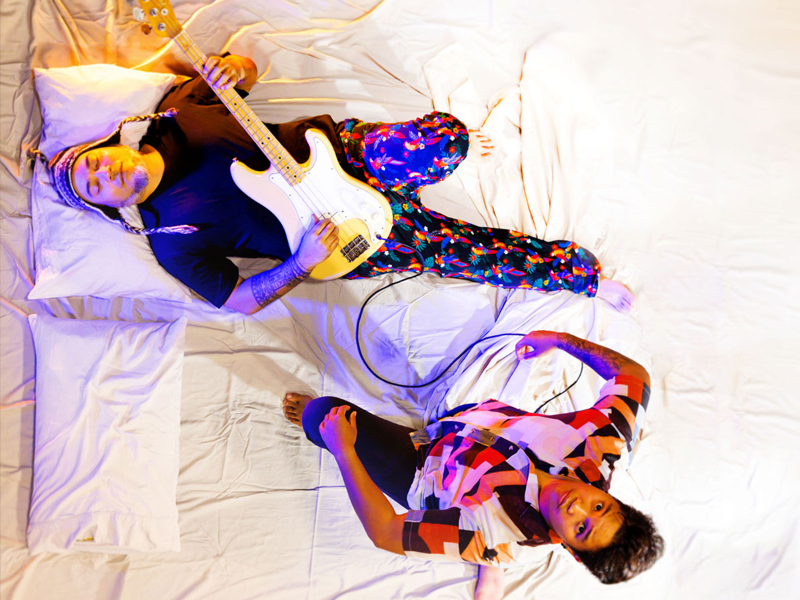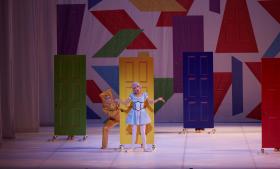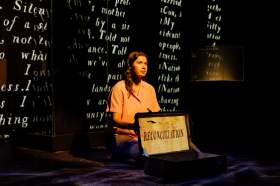Audiences may be familiar with the work of James Mangohig, aka Kuya James, through a number of his previous collaborative efforts, be that the national tour of In Between Two with Joelistics, many a sound design for Tracks Dance or his ability to amplify and expand the work of other musicians through his ARIA-nominated work as a producer. In Hymns for the Witching Hour Mangohig takes the microphone and centre stage to share his own deeply personal story.
Mangohig describes the inspiration for this work as an ongoing journey of coming to terms with the dissonance of his Christian upbringing and the person he finds himself as today. The vehicle for this exploration are the bedtime stories he was told as a child: tales of angels, devils, salvation and spiritual warfare. These are somewhat recreated on stage through dance, voiceover and projection, as both he and the audience try to make sense of these coming of age ideas. They’re timeless themes beyond religion and speak to the pressure of cultural identity, family legacy and how we make sense of the past when it still feels very present.
Ghosts of cultural folklore, the Bible and childhood imagination are blended into Jocelyn Tribe and Pj’s visual design for the work. The space is minimal, sparse and clean. A bungalow-like structure takes centre stage with translucent mosquito mesh flanking the wooden poles of its structure. Inside and above hang pendant lights, which allow us at times to peer into the bedroom and inner landscape of Mangohig, who spends most of his time in this structure watching and listening. It’s both a haunting image of entrapment and a playful call to childhood nostalgia.
The three dancers (Kino McHugh, Ruttiya McElroy and Steph Spillett) – occasionally joined by Mangohig, who is also on stage as a kind of voyeur – take shape as menacing forces, manipulating Mangohig and nursing him back to sleep again. The final character in the piece is Mangohig’s father, present through voiceover recounting Biblical scripture and doctrine throughout.
Kino McHugh’s choreography fuses contemporary and hip hop styles to create something restrained, gestural and hypnotic. As the dancers rotate in trio, solo and duo formations, the movement plays a reactive role in response to the soundtrack, the objects in the space, the voiceovers and religious symbology. The choreography truly comes to life through the body of McHugh herself whose energy, strength and precision is electric.
Biblical literalism is a contentious issue for some contemporary Christians and, by their nature, children. It suggests that the Bible is a literal book of facts rather than open for interpretation as allegory, poetry or metaphor. The same wrestling between the literal and the symbolic in this work is both an insight into being raised as a child in Christian indoctrination as well as a struggle in the form itself. Moments of lyrics in the music of the piece take us from the pleasure of the abstract into a clanging literal simplification, a Corinthians inspired love song, for example.
I struggled to place this work as I watched it. Its misleading ‘immersive’ marketing description left me waiting for a breaking of the fourth wall in any way. As the show unfolded and I let go of the obviousness of the track-by-track dance form, what was left was a striking visual album. Richness and depth live just beyond the surface and it makes for a fantastical listening party. On opening night, the audience were brought to applause in these natural track breaks. The artist’s personal statements at the beginning and end of the work contextually make much more sense as album cover notes. The musical score dominates as the hook and the most engaging part of this work. Its rich electro down tempo beats are the centrepiece and hero of the work.
The lighting design by Tomm Lydiard does well to showcase each track in this album with some distinctly beautiful images balancing the background of the translucent structure and the foreground of the dancers. At times though it is a little heavy-handed in its overscoring of already, again, literal moments (think: scary angry demons – heavy red lighting; love is patient, love is kind – pink soft lighting).
Read: Theatre review: Worstward Ho, Theatre Works
When the personal and autobiographical are exposed on stage in a way such as in this show, it can open a vein of vulnerability that steps a little beyond the theatrical and places audiences as outsiders to a journey of personal healing. The work walks a fine line in tipping into some hyperreality through Mangohig being author and performer, present and a known figure to much of the audience, but it’s ultimately brought together with a gentle spirit and a message of hope.
From the deeply personal we can see the universal, and the music has a lasting self-reflective impact. Hymns for the Witching Hour is intriguing and worth a listen and a watch to find out what you see (and hear) in yourself.
Hymns of the Witching Hour by Kuya James
Brown’s Mart Theatre
Choreographer: Kino McHugh
Co-Designers: Jocelyn Tribe and Pj
Lighting Designer: Tomm Lydiard
Dramaturg: Roslyn Oades
Movement Director: Jessica Devereux
Sound Mastering/Consulting: Mat Cunliffe
Performers: Kino McHugh, Kuya James, Ruttiya McElroy and Steph Spillett
Tickets: from $28
Hymn of the Witching Hour will be performed until 3 June 2023.





